The Montana Suffrage Story
On November 3, 1914, Montana men voted 53 to 47 percent in favor of equal suffrage. That year Montana (and Nevada, which also passed a suffrage amendment in 1914) joined nine other western states in extending voting rights to non-Native women. (Indian women would have to wait until passage of the 1924 Indian Citizenship Act to gain access to the ballot.)

The suffrage victory was the result of a sophisticated and multifaceted organizing campaign. Jeannette Rankin is undoubtedly Montana’ most famous suffragist, but the movement’s final triumph involved hundreds of women across the state. Belle Fligelman, of Helena, shocked her mother by speaking on street corners and in front of saloons. The Women’s Christian Temperance Union mobilized its 1,500 members to engage in a neighbor-to-neighbor campaign. Margaret Smith Hathaway, of Stevensville, traveled over 5,700 miles promoting the cause, earning the nickname “the whirlwind.” And local groups, like the Missoula Teachers’ Suffrage Committee, published and distributed 30,000 copies of their leaflet “Women Teachers of Montana Should Have the Vote.” Together, they created the momentum to see equal suffrage pass, twenty-five years after, at his wife Clara’s behest, Perry McAdow first proposed equal suffrage at Montana’s 1889 constitutional convention. Suffrage supporters rejoiced and followed up their victory in 1916 by electing Maggie Smith Hathaway (D) and Emma Ingalls (R) to the state legislature, Jeannette Rankin (R) to Congress, and May Trumper (R) as Superintendent of Public Instruction. Learn more about Montana’s suffrage story from the resources below.
1914 Suffrage Vote Map

Suffrage Bibliography
This bibliography includes nonfiction books, government documents (federal, tribal, state, county, and city), published reports, ephemera, theses and dissertations, unpublished manuscript collections, and other materials concerning Montana women’s suffrage. Download PDF List | View Online
Montana and National Women’s Suffrage
Montana women fought for national women’s suffrage as well. Check out this video on Hazel Hunkins-Hallinan of Billings for more information!
Suffrage in the News
Looking back, we may be surprised that women in the United States were ever denied the right to vote. Examining news stories of the time period helps us understand why the proposal was controversial and how the arguments for and against played out—in print—in real time. By collecting in one location more than six million keyword-searchable newspaper pages from over 30 states, Chronicling America provides us an opportunity to uncover those varying opinions faster and more efficiently than ever before. Below are a sampling of articles from Montana papers—including the suffrage movement’s own newspaper, Suffrage Daily News—that the Montana Historical Society has digitized for Chronicling America. Looking for more stories—from Montana or nationally? The following search terms may help retrieve articles related to this topic: vote for woman, equal suffrage, universal suffrage, Susan B. Anthony, chivalry, universal emancipation, procession (i.e. a march), “separate spheres,” and “petticoat rule.”
Selected Clippings
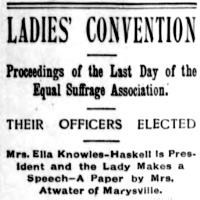
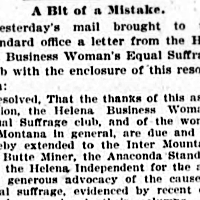

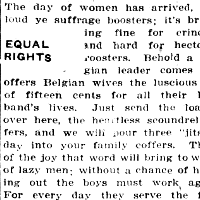

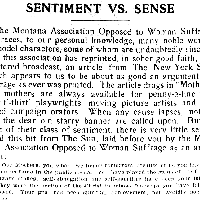
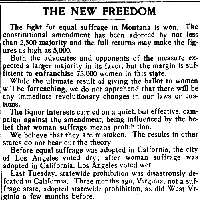
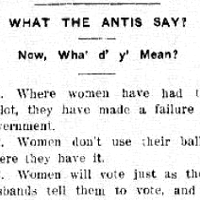

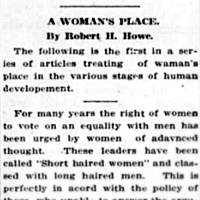
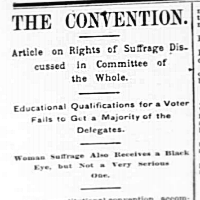
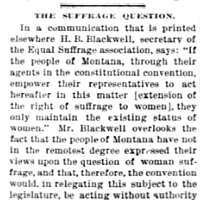
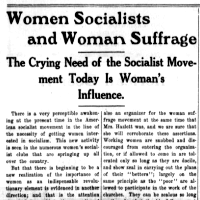
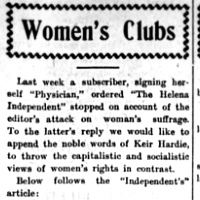
Hello! I am a shop owner in historical downtown great falls mt. I am helping a lady find a suffragette costume. I think they will be doing a parade and re enactment of sorts. I am doing research and need to know if mt had its own sash colors or other themes unique to Montana’s suffragettes. Thank you for your time! Serena webb
Hi Serena! Pulling together a suffrage costume sounds like a very fun project. Nationally suffragists wore purple, yellow, and white (which together made up the colors of the suffrage tri-color banners). The sunflower was also a symbol of the suffrage movement.
More locally, we know that in 1914 there was a huge suffrage parade in Helena. This article from the Suffrage Daily News reported that all the suffragists wore yellow dresses and yellow headbands reading “VOTES FOR WOMEN.” Many parade marchers would have also worn sashes across the chest saying “VOTES FOR WOMEN.” This picture is from a national march, but it shows the great sashes! Suffragists also dressed up as famous female heroes from history, as you can see in this picture of Inez Milholland, who dressed up as Joan of Arc to lead the 1913 suffrage march in Washington, D.C.
As an additional fun fact: the word “suffragette” was actually a derogatory term invented by the press and those who opposed the women’s suffrage movement. Activists like those who marched in the Helena parade would have preferred the term “suffragist,” which could include both male and female activists. Over time the difference between the two terms became obscured, so the nuance seems strange to us today.
We wish you the best of luck in finding a costume, and please let us know if there’s anything else we can do to help!
Thank you so much!
I would like to help.
Could someone tell me whether and where there is information concerning my grandmother, Elizabeth Morrow Rust, who was in 1912 or so Chair of the Montana League of Women Voters?
The Reference Historians at the Montana Historical Society Research Center may be able to help you: http://mhs.mt.gov/research/services/requests.
Hello,
Always have been a believer that women were the straw that broke the white man entitlist back. I have to wonder as there always two sides to a coin. sufferage rights had at least that.
But I am finding that the the sufferage movement was infact a tool to ensure white superiority. I am not saying that is or could be the issue today, I just hate how most often the real history seems to blow away the history we were taught.
The history of White Protestant Men and ideals seem to relate to KKK ideals. Although I realize the KKK was formally founded in 1865, two years after the Emancipation Proclamation. It was pretty much accepted and there was no need to display white pride, people in that time knew their roles. (So to speak)
How much of our history, is as we were taught, and how much of women’s history wasn’t included because it would mar the current ideal, or even go as far as proving the sentiment was and is about white supremacy? Is that why our books try to limit exposure to history?
I am interested in finding out what is known and what resources are available concerning Rose Elizabeth Morrow Rust from Missoula. She was born in Montana in the 1880’s. She was, I believe, chair or president of the Montana League of Women Voters at some time in the period from 1910 to 1914. She attended several National Political Party Conventions during this period. Thank you.
You might want to check with our research center: http://mhs.mt.gov/research/services/requests. The archives at the Mansfield Library may also have information. Good luck!
It’s exciting to see your on line research materials. I have taken advantage of them.
I’m researching a suffrage worker who spent some time in Granite/Phillipsburg and am now searching for information on teachers in the two communities. I am also searching how involved the women of the area were in the forming of the mining unions.
Thanks for he article. We will mention names in this article next Tuesday March 9, 1pm EST, Via Live Zoom. Capitol Conversations. please join us.
capitolconvos@visitthecapitol.gov
Were there any notable Native American Women I should mention or research?
Thanks Ronn Jackson, US capitol Building, US Capitol Tour Guide.